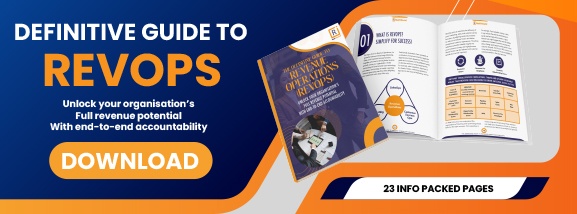In the fast-paced world of business, finding ways to optimise revenue generation is paramount. As enterprise organisations continue to grow and expand their operations, they often encounter challenges related to siloed departments, disjointed processes, and misaligned strategies. This is where Revenue Operations, often referred to as RevOps, emerges as a game-changer. In this article, we'll break down the concept of RevOps in simple terms that any enterprise organisation can understand and explain why developing a RevOps strategy and team should be on the top of their priority list.
Whats this thing called RevOps
At its core, Revenue Operations (RevOps) is a strategic approach that brings together different operational functions within an organisation to drive cohesive revenue growth. It's like creating a symphony of harmonious efforts across marketing, sales, and customer service, all aimed at achieving one common goal: maximising revenue potential. RevOps aligns the people, processes, technology, and data across these departments to ensure they work in synergy, resulting in improved customer experiences and streamlined revenue generation.
Why should I care about RevOps? Why is it important?
Picture a bustling marketplace where vendors offer their wares – each with their unique strengths. Now imagine that these vendors are your company's departments: marketing, sales, and customer service. Each one excels in their own right, creating fantastic campaigns, converting leads, and delighting customers. However, what if they were operating independently, without communication or coordination? This scenario could lead to missed opportunities, disjointed customer experiences, and potential revenue losses. Enter Revenue Operations, or RevOps, the connective tissue that ensures all the pieces work together seamlessly.
In today's fiercely competitive business environment, customers have come to expect interactions that are tailor-made and effortless. RevOps acknowledges this need and places its focus on aligning your teams and processes to deliver a unified and exceptional experience. By erasing the boundaries between departments and fostering collaboration, RevOps takes customer satisfaction to new heights, ramps up operational efficiency, and paves the way for revenue growth.
RevOps isn't just a concept; it's the bridge that links your marketing, sales, and customer service functions. It empowers them to collaborate like an orchestra, with each instrument playing in harmony to produce a symphony of success. This synchronisation doesn't just happen by chance – it's the result of strategic planning, technology integration, and a shared vision.
In this dynamic landscape, where customer expectations are higher than ever before, RevOps stands as the driving force behind a seamless customer journey. It ensures that whether a potential customer interacts with your marketing materials, engages with your sales team, or seeks support from your customer service, the experience is consistent and satisfying. This consistency not only leads to happier customers but also bolsters operational efficiency and, in turn, drives revenue growth.
So, why is RevOps important? It's the linchpin that prevents departments from working in isolation and ensures they operate like a well-coordinated dance troupe. It's the strategy that synchronises processes, aligns technology, and unifies teams. It's the blueprint for enhanced customer experiences, optimised workflows, and ultimately, a more profitable bottom line.
RevOps might be a new term to some, but its importance cannot be overstated. It's the navigational guide that helps your organisation steer through the complexities of the modern business landscape. As customers' expectations continue to evolve, RevOps remains the key to unlocking their loyalty and driving your business towards sustainable growth.
What is RevOps Strategy Different?
Think of a RevOps strategy as the master plan that guides a company's efforts to bring marketing, sales, and customer service into a powerful revenue-boosting alliance. It's like the architect's blueprint for constructing a seamless pathway that leads customers from initial interest all the way to becoming loyal advocates. This strategy involves pinpointing the essential processes, setting up metrics for measurement, and introducing tools that work together to orchestrate revenue growth. And just like a blueprint ensures a building stands strong, a RevOps strategy ensures that each customer interaction strengthens the bottom line.
Crafting a successful RevOps strategy means thinking about the entire customer journey, much like plotting out a novel from its intriguing beginning to its satisfying end. It's not just about getting customers in the door; it's about keeping them delighted even after they've made a purchase. This comprehensive approach ensures that no opportunity for revenue growth goes unnoticed.
An effective RevOps strategy is like a conductor leading an orchestra – it ensures that every instrument plays in harmony. It demands that data flows seamlessly between departments, making sure that marketing, sales, and customer service are always on the same page. By doing so, it identifies spots where the melody might falter, processes could be streamlined, or departments could collaborate better. In essence, it fosters a culture of teamwork and alignment.
With a well-defined RevOps strategy in place, enterprise organisations can make sure their ship sails smoothly. Imagine a ship where the crew members share information seamlessly, anticipate each other's moves, and work together to navigate treacherous waters. That's what a RevOps strategy accomplishes for your organisation. It maximises the value of every customer interaction, optimises workflows, and creates an environment where all hands-on deck contribute to revenue growth.
In summary, a RevOps strategy is like a treasure map that guides your company to revenue success. It ensures that all the moving parts – marketing, sales, and customer service – work together to create a harmonious and revenue-driven experience for your customers. By carefully crafting this strategy, enterprise organisations can chart a course towards enhanced revenue outcomes and business growth.
Pillars of RevOps
RevOps rests on several key pillars that collectively drive its success:
- Data Harmony
Imagine a symphony where each instrument plays in perfect harmony, creating a beautiful and captivating melody. Just like the different sections of an orchestra need to be in sync, departments within an organisation must also operate seamlessly together. This is where data harmony steps in – it ensures that the flow of information is smooth and uninterrupted across various departments.
Think of your data as the musical notes that guide the entire performance. When data is accurate, unified, and easily accessible, it empowers your organisation to make well-informed decisions. It's like having a conductor who knows exactly when each instrument should play its part. With the right data, your organisation can identify patterns, preferences, and behaviours that drive customer engagement and revenue growth.
Imagine you're a conductor leading an orchestra. Each musician has their own part to play, but their timing and coordination are crucial to create a harmonious melody. In the same way, different departments in your organisation contribute to the overall performance. Marketing, sales, and customer service each have unique roles, but when they're synchronised through shared data, they create a cohesive and impactful customer experience.
Data harmony enables personalisation, much like a composer tailors a piece to resonate with the audience. When your organisation understands customer preferences, pain points, and history, you can offer tailored solutions and experiences. It's like playing a tune that resonates deeply with the listener. Unified data allows you to provide the right solutions at the right time, increasing customer satisfaction and loyalty.
Moreover, data harmony uncovers hidden gems – revenue opportunities that might have otherwise gone unnoticed. It's like having a skilled musician find a subtle yet exquisite note that adds a new layer to the music. Accurate and shared data highlights potential areas for growth, enabling your organisation to capitalise on untapped markets, upsell opportunities, and customer needs.
In essence, data harmony is the conductor that ensures each department plays its role with precision. Just as a symphony's success relies on every musician following the conductor's cues, your organisation's success depends on accurate and unified data guiding decision-making, personalisation, and revenue optimisation. Just as an orchestra creates a memorable performance, your organisation can create remarkable customer experiences and drive revenue growth through the harmonious flow of data.
- Process Optimisation:
Imagine a well-choreographed dance routine where every step is perfectly timed and executed. Just as dancers practice tirelessly to ensure their movements flow seamlessly, organisations must also refine their processes to create a frictionless customer journey. This is where process optimisation, a key pillar of RevOps, comes into play.
Picture your organisation as a dance troupe, each department representing a different dancer. Just as dancers need to coordinate their movements for a flawless performance, departments must collaborate to provide a consistent and efficient customer experience. Process optimisation is like rehearsing the dance routine, identifying areas where steps can be refined, and ensuring every move aligns with the overall rhythm.
Think of a customer's journey as a dance sequence. Each touchpoint, from the initial interaction with marketing to post-sale support from customer service, is a step in the choreography. Process optimisation ensures that these steps are well-defined, streamlined, and free from unnecessary complications. It's like perfecting the routine so that each movement seamlessly leads to the next.
Imagine you're choreographing a complex dance with multiple performers. Each dancer needs to know their cues, transitions, and positions to create a harmonious performance. Similarly, process optimisation involves mapping out workflows and ensuring that departments understand their roles in delivering a cohesive customer experience. This alignment reduces confusion, minimises delays, and enhances overall efficiency.
Process optimisation doesn't just make the journey smoother; it also enhances consistency. Just as dancers practice until their movements become second nature, departments refine their processes to ensure a consistent and predictable customer experience. Whether a customer interacts with marketing, sales, or customer service, the experience remains coherent and aligned.
Moreover, process optimisation uncovers opportunities for improvement, similar to refining dance moves for maximum impact. By analysing each step of the customer journey, organisations can identify bottlenecks, redundancies, and areas where friction occurs. This insight enables refinements that lead to quicker sales cycles, improved customer satisfaction, and increased revenue.
In summary, process optimisation is the choreography that transforms individual interactions into a cohesive customer journey. Just as a dance routine requires meticulous planning and rehearsal, organisations must map out, refine, and align their processes to ensure a seamless and consistent experience. Through process optimisation, your organisation can dance through the customer journey with grace and efficiency, delivering exceptional value and driving revenue growth.
- Technology Alignment
In the modern business landscape, technology serves as the backdrop to every operation. It's like the stage upon which the performance of your organisation unfolds. Just as a theatre production requires the right lighting, props, and set design, your business needs a well-aligned technology stack to support seamless operations. This is where technology alignment, a fundamental pillar of RevOps, takes centre stage.
Imagine your business as a grand production, with different departments as actors and each customer interaction as a scene. Technology is the behind-the-scenes crew, providing the tools and systems necessary to deliver a flawless performance. Technology alignment ensures that these tools work in harmony, complementing each other to create a cohesive and efficient experience for both your teams and your customers.
Think of your technology stack as a symphony orchestra, with each tool representing a different instrument. Just as a conductor ensures that each instrument plays its part in harmony, technology alignment ensures that your tools are integrated and synchronised. This alignment allows data to flow seamlessly across departments, enabling informed decision-making and personalised customer interactions.
Technology alignment also involves automating repetitive tasks, much like using stage machinery to swiftly change scenery between scenes. Just as automation reduces manual labour and speeds up scene transitions, technology alignment streamlines processes by automating routine tasks. This frees up your teams to focus on higher-value activities, such as building relationships and strategising for revenue growth.
Consider a business as a puzzle, with each tool as a piece that fits together to create a complete picture. Technology alignment ensures that these pieces interlock seamlessly, eliminating gaps and overlaps that could disrupt the overall image. Through proper integration, your technology stack becomes a cohesive ecosystem that supports efficient operations and consistent customer experiences.
Moreover, technology alignment drives operational effectiveness. Just as the backstage crew works diligently to ensure a flawless performance, your technology stack works behind the scenes to enhance productivity, accuracy, and efficiency. By aligning your tools with your RevOps strategy, you empower your teams to work cohesively, provide exceptional service, and drive revenue growth.
In summary, technology alignment is the orchestration that ensures your technology tools work together harmoniously to support your organisation's performance. Just as a well-coordinated crew enhances a theatrical production, technology alignment enhances your business operations, enabling data sharing, task automation, and overall operational excellence. Through proper alignment, your technology stack becomes a powerful enabler of revenue optimisation and business success.
- Team Collaboration
In the world of business, success often depends on the collective efforts of your teams working together harmoniously. Just as an orchestra's various sections must collaborate to create a beautiful symphony, your organisation's different departments must collaborate to achieve optimal revenue outcomes. This is where team collaboration, a key pillar of RevOps, takes centre stage.
Imagine your organisation as a symphony orchestra, with each department representing a different section: strings, woodwinds, brass, and percussion. Just as these sections must synchronise their performances to create a cohesive musical masterpiece, your departments must collaborate to create a unified customer experience and drive revenue growth.
RevOps recognises that silos within an organisation can hinder progress and lead to disjointed customer interactions. Instead of each department playing its own tune, RevOps encourages departments to work together as an ensemble, playing in harmony to achieve a collective goal. When marketing, sales, and customer service teams collaborate, the result is a symphony of coordinated efforts that resonates with customers and drives revenue.
Imagine a conductor leading an orchestra, guiding each section to play in sync and bringing out the best in every musician. Similarly, RevOps acts as the conductor of your organisation, aligning teams around shared goals and strategies. This alignment ensures that every department is on the same page, working cohesively to deliver a consistent and satisfying customer experience.
Team collaboration is not just about breaking down silos; it's also about fostering a culture of unity and mutual support. Just as musicians listen to each other and adjust their playing to fit the overall sound, your teams collaborate to share insights, ideas, and best practices. This collaborative spirit leads to innovation, efficiency, and the ability to adapt quickly to changing customer needs.
Furthermore, team collaboration improves coordination, much like dancers moving in perfect synchrony during a choreographed performance. With departments aligned and communicating effectively, there's no confusion or duplication of efforts. This streamlined coordination enables your organisation to respond swiftly to customer inquiries, tailor solutions to individual needs, and seize revenue opportunities.
In summary, team collaboration is the harmonious collaboration of different departments to create a unified and seamless customer experience. Just as an orchestra's harmonious performance captivates audiences, your organisation's collaborative efforts captivate customers and drive revenue growth. Through RevOps-driven collaboration, your teams become the ensemble that delivers exceptional service and ensures business success.
- Metrics and Reporting
Imagine running a race without knowing how far you've come or where the finish line is. In the world of business, metrics and reporting play a similar role—they provide the necessary insights to track progress, make informed decisions, and continuously improve. This pillar of RevOps is all about ensuring that organisations have a clear understanding of their performance and the means to drive success.
Metrics and reporting serve as the compass that guides your organisation's revenue journey. Just as a navigator uses a map to chart a course, your business relies on metrics to understand where it stands and where it's headed. By establishing clear and meaningful metrics, RevOps empowers organisations to gauge their performance accurately.
Consider a pilot navigating through the skies. They rely on a dashboard of instruments to monitor altitude, speed, and direction. Similarly, metrics act as your organisation's dashboard, providing real-time insights into key performance indicators (KPIs). These KPIs are the essential data points that measure various aspects of your revenue operations.
RevOps enables organisations to define and track KPIs that align with revenue goals. These KPIs span a wide range of areas, from lead generation and conversion rates to customer retention and revenue growth. Just as a pilot adjusts their flight path based on instrument readings, your organisation can make data-driven decisions by analysing KPI trends and patterns.
Metrics and reporting go beyond merely observing data; they empower organisations to take action. Imagine a captain steering a ship through treacherous waters. With accurate navigation charts and real-time updates, they can navigate obstacles and make informed decisions to reach their destination safely. Similarly, organisations armed with meaningful metrics can steer their strategies, refine processes, and overcome challenges to achieve revenue goals.
Think of reporting as the captain's log—a detailed record of the journey. Reports provide a comprehensive overview of your organisation's performance, highlighting achievements, identifying areas for improvement, and uncovering growth opportunities. By regularly reviewing reports, you gain valuable insights that guide your decisions and keep you on course toward success.
Metrics and reporting also foster accountability and transparency. Just as a team of explorers shares findings with their expedition leader, departments share their performance metrics in a collaborative environment. This transparency promotes cross-functional understanding, encourages shared goals, and motivates teams to work collectively toward revenue growth.
In conclusion, metrics and reporting are the navigational tools that empower organisations to measure performance accurately, make informed decisions, and drive continuous improvement. Just as a skilled navigator ensures a smooth journey, RevOps-driven metrics and reporting ensure that your organisation's revenue journey is well-guided and successful. Through data-driven insights, your organisation can optimise strategies, adapt to changing conditions, and ultimately achieve remarkable growth.6. Customer-Centric Approach: RevOps revolves around delivering exceptional customer experiences. By aligning departments to prioritise customer satisfaction, organisations build lasting relationships and drive repeat business.
- Continuous Improvement
Embracing a culture of continuous improvement lies at the heart of a successful RevOps strategy. Rather than considering RevOps as a one-time implementation, organisations that prioritise continuous refinement are better poised to navigate the dynamic landscape of business.
In this journey, every facet of your operations evolves to align with the changing market conditions and capitalise on emerging opportunities. As your company grows and the market evolves, RevOps remains fluid, ensuring that processes, technologies, and strategies remain finely tuned.
This ongoing commitment to improvement propels your business forward by addressing challenges as they arise and enhancing your competitive edge. By fostering an environment where adaptation is embraced, you empower your teams to evolve alongside your business, positioning you to consistently achieve outstanding results.
In essence, continuous improvement within RevOps isn't just a strategy; it's a philosophy that fuels perpetual growth. With every tweak, optimisation, and innovation, you propel your organisation closer to its goals, establishing a powerful cycle of advancement that keeps you ahead of the curve.
Incorporating RevOps into Enterprise Organisations
Integrating RevOps into an enterprise organisation involves a strategic shift. It's about recognising that revenue generation is a collective effort and that every department plays a pivotal role. The transition may not be instant, but the rewards are significant.
By embracing RevOps, enterprise organisations can expect:
- Increased revenue due to improved customer experiences and streamlined processes.
- Better alignment between marketing, sales, and customer service, leading to more effective strategies.
- Enhanced data-driven decision-making, resulting in accurate forecasting and higher conversions.
- Improved operational efficiency and reduced redundancies, leading to cost savings.
- A culture of collaboration, where teams work together to achieve common revenue goals.
In Conclusion
In the world of enterprise organisations, revenue optimisation is a continuous pursuit. Revenue Operations (RevOps) offers a compelling solution to the challenges of silos, inefficiencies, and disjointed strategies. By embracing RevOps, organisations can align their departments, streamline processes, and deliver exceptional customer experiences—all of which contribute to unlocking their full revenue potential.
If you're ready to embark on the journey of RevOps transformation, consider partnering with experts like Real Inbound, who specialise in Revenue Operations strategy and implementation. With RevOps, your enterprise organisation can harmonise efforts, orchestrate growth, and achieve remarkable revenue outcomes.






